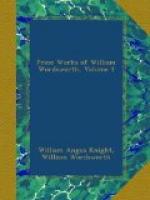After a quotation from Whitaker. I cannot conclude without recommending to the notice of all lovers of beautiful scenery, Bolton Abbey and its neighbourhood. This enchanting spot belongs to the Duke of Devonshire; and the superintendence of it has for some years been entrusted to the Rev. William Carr, who has most skilfully opened out its features; and in whatever he has added, has done justice to the place, by working with an invisible hand of art in the very spirit of Nature.
* * * * *
XIV. ECCLESIASTICAL SONNETS.
332. Ecclesiastical Sonnets in Series.
ADVERTISEMENT.
During the month of December, 1820, I accompanied a much-beloved and honoured Friend in a walk through different parts of his estate, with a view to fix upon the site of a new Church which he intended to erect. It was one of the most beautiful mornings of a mild season,—our feelings were in harmony with the cherishing influences of the scene; and such being our purpose, we were naturally led to look back upon past events with wonder and gratitude, and on the future with hope. Not long afterwards, some of the Sonnets which will be found towards the close of this series were produced as a private memorial of that morning’s occupation.
The Catholic Question, which was agitated in Parliament about that time, kept my thoughts in the same course; and it struck me that certain points in the Ecclesiastical History of our Country might advantageously be presented to view in verse. Accordingly, I took up the subject, and what I now offer to the reader was the result.
When this work was far advanced, I was agreeably surprised to find that my friend, Mr. Southey, had been engaged with similar views in writing a concise History of the Church in England. If our Productions, thus unintentionally coinciding, shall be found to illustrate each other, it will prove a high gratification to me, which I am sure my friend will participate.
W. WORDSWORTH.
Rydal Mount, January 24, 1822.
For the convenience of passing from one point of the subject to another without shocks of abruptness, this work has taken the shape of a series of Sonnets: but the Reader, it is to be hoped, will find that the pictures are often so closely connected as to have jointly the effect of passages of a poem in a form of stanza to which there is no objection but one that bears upon the Poet only—its difficulty.
333. *_Introductory Remarks_.




